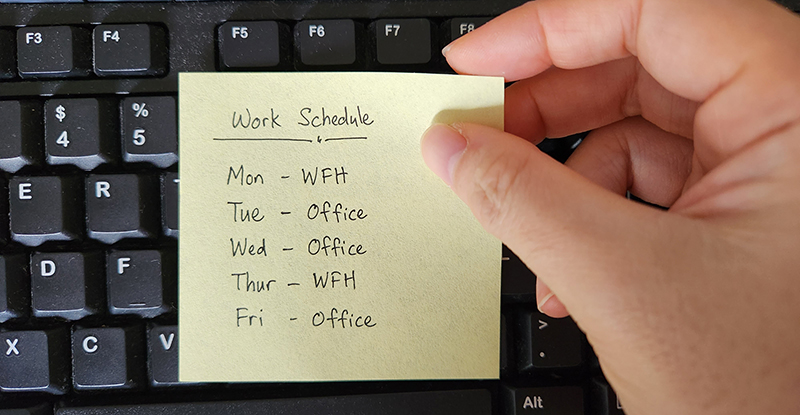
After two years of work that was definitely not normal, the hybrid workplace (sometimes referred to as the “flexible” workplace) is meant to provide a partial return to life as we knew it pre-pandemic. But while there are many perceived benefits to this new hybrid approach, it’s too soon to tell how it will actually play out.
Some of the challenges
When employers sent everyone home in March 2020, there was one clear driver for doing so: COVID-19. There was no time for focus groups, as employers had to act swiftly. Outside of those working in essential services, employees were asked to pivot quickly and do the best they could working from home.
Now organizations are transitioning again, but this time it’s different, because there isn’t necessarily an external driver forcing us back. Without a clear imperative, many organizations are asking: “Do we really need people to come into the office?”
Adding to the complexity is the success of remote work. While the transition to working from home was undoubtedly a chaotic and challenging process, it also proved far more successful for many organizations than expected. Employees experienced a level of flexibility they’d never had before, and employers gained a better sense of the true diversity of employee needs.
Now, as we look at a hybrid landscape, employers and employees alike have to consider everything from commute times to childcare/eldercare responsibilities to the need for quiet or collaborative work. One-size-fits-all policies won’t cut it—employees need flexible strategies that will allow them to be at their best and most productive.
Three tools to better navigate a hybrid work world
As we wait to see how things unfold, there are steps we can take to set ourselves up for success.
- Be present and aware
Our mindset colours our world, influencing what we pay attention to and how we behave. Accordingly, it affects our results. If you’re feeling unsure about the hybrid workspace, know that you’re not alone. This is a new and uncharted landscape, and almost everyone is wrestling with some level of uncertainty. It will be messy and uncomfortable at times. Set realistic expectations to avoid being disappointed when things don’t go as planned. Avoid complaining about the things you can’t control and focus instead on the things you can. Know that when it comes to the hybrid workspace, where we start off is unlikely to be where we’ll end up.
Do your best to take care of both your physical and mental well-being. Once you’ve taken care to implement self-supporting practices, you can shift from a “me and my needs” focus to a “we and our needs” approach. After all, many of the benefits of returning to the office are related to community building. Mentoring new hires, strengthening bonds with colleagues, and engaging in social activities all contribute to a positive workplace culture—one that is more attractive to and productive for everyone. When you’re working at the office, be fully present with your colleagues and enjoy the experience of connecting with them again. Enjoy the ease of discussion and collaboration and the joy of having lunch with a co-worker, for example. And when you’re working at home, be fully aware of the many benefits there too, such as having your pet nearby and having access to a stocked fridge.
- Manage your energy
Generally speaking, introverts and extroverts process energy differently. Whereas introverts typically need solitude to recharge their batteries, extroverts typically recharge by being around others. Whether you tend toward introversion or extroversion, the hybrid workplace should enable you to find a good balance, as long as you remain mindful and aware of your energy needs. If you’re able to set your own hybrid schedule, try to balance your office days and home days to optimize your energy.
Be aware that we all have different energy needs and life circumstances, and be supportive and respectful of the needs of others, particularly if you’re in a leadership position and able to influence the level of flexibility and autonomy afforded to your reports.
- Balance focus time with collaboration time
Even before the pandemic, this was a big issue in most workplaces. Open-concept offices, Slack channels, meeting overload, and cultures that promoted constant connectivity (which can translate to constant interruption) were all hindering people’s ability to focus and get their work done before COVID-19 reared its head.
Just as bouncing between working from home and working at the office gives you an opportunity to balance your energy needs, it also provides an opportunity to balance your two main productivity modes: focus time and collaboration time. Figure out what you need to be at your most productive so you can be more intentional about how you spend your days working from home and at the office. The goal will be to find the right balance for you and the people with whom you connect. Expect this process to require some good communication, and make the effort to maintain open and regular dialogue throughout.
Forging ahead
In the end, we’re all in this together. The hybrid workplace is just another step in our collective journey through the COVID-19 pandemic, and we’re figuring it out together as we go. Don’t underestimate how successful we can all be if we keep an open and positive mindset, manage our energy, and balance the time we need for both focus and collaboration.
Scott Orth, M.Sc., CPCC, is a mindfulness and resiliency trainer and coach who gives leaders and busy professionals the tools they need to thrive in an often chaotic and distracting world. He was previously the national HR leader for one of Canada’s largest employee-owned engineering and science consulting organizations.
This article was originally published in the July/August 2022 issue of CPABC in Focus



